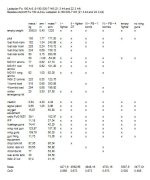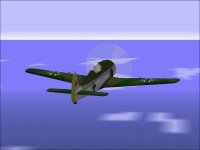The Focke Wulf 190A was one of my early projects for Combat Flight Simulator.
It was originally done with very little research as to actual flight performance.
The visual model was done pretty much by eyeball measurement of a few drawings and an old MPC / Airfix 1:72 scale FW 190A model kit.
It was first released here probably a bit over 10 years ago and has been updated about three times in all.
The first update was to add a pilot once I had built a pretty fair model of a pilot's head and shoulders.
The second update was to reshape the cowl opening and add an animated cooling fan.
The third update was to add some bulges on the sides of the cowl.
Somewhere along the way it also got a reshaped fin and rear antenna mount.
This revisit is its latest update to bring it closer to current standards hopefully without any major reworking. My son once complained about one of my other models that there was no opening for the landing gear to retract into. This update was started to address this complaint.
The first screenshot looks generally pretty good but actually shows plenty of errors which will become obvious later.
The second screenshot shows a gap between the inner gear door and the underside of the fuselage. There also appears to be a visual issue with the main gear door but I didn't see this when taking the screenshot.
The third screenshot shows the original panel lines and gear doors which are somewhat incorrect.
It was originally done with very little research as to actual flight performance.
The visual model was done pretty much by eyeball measurement of a few drawings and an old MPC / Airfix 1:72 scale FW 190A model kit.
It was first released here probably a bit over 10 years ago and has been updated about three times in all.
The first update was to add a pilot once I had built a pretty fair model of a pilot's head and shoulders.
The second update was to reshape the cowl opening and add an animated cooling fan.
The third update was to add some bulges on the sides of the cowl.
Somewhere along the way it also got a reshaped fin and rear antenna mount.
This revisit is its latest update to bring it closer to current standards hopefully without any major reworking. My son once complained about one of my other models that there was no opening for the landing gear to retract into. This update was started to address this complaint.
The first screenshot looks generally pretty good but actually shows plenty of errors which will become obvious later.
The second screenshot shows a gap between the inner gear door and the underside of the fuselage. There also appears to be a visual issue with the main gear door but I didn't see this when taking the screenshot.
The third screenshot shows the original panel lines and gear doors which are somewhat incorrect.
Attachments
Last edited:

















